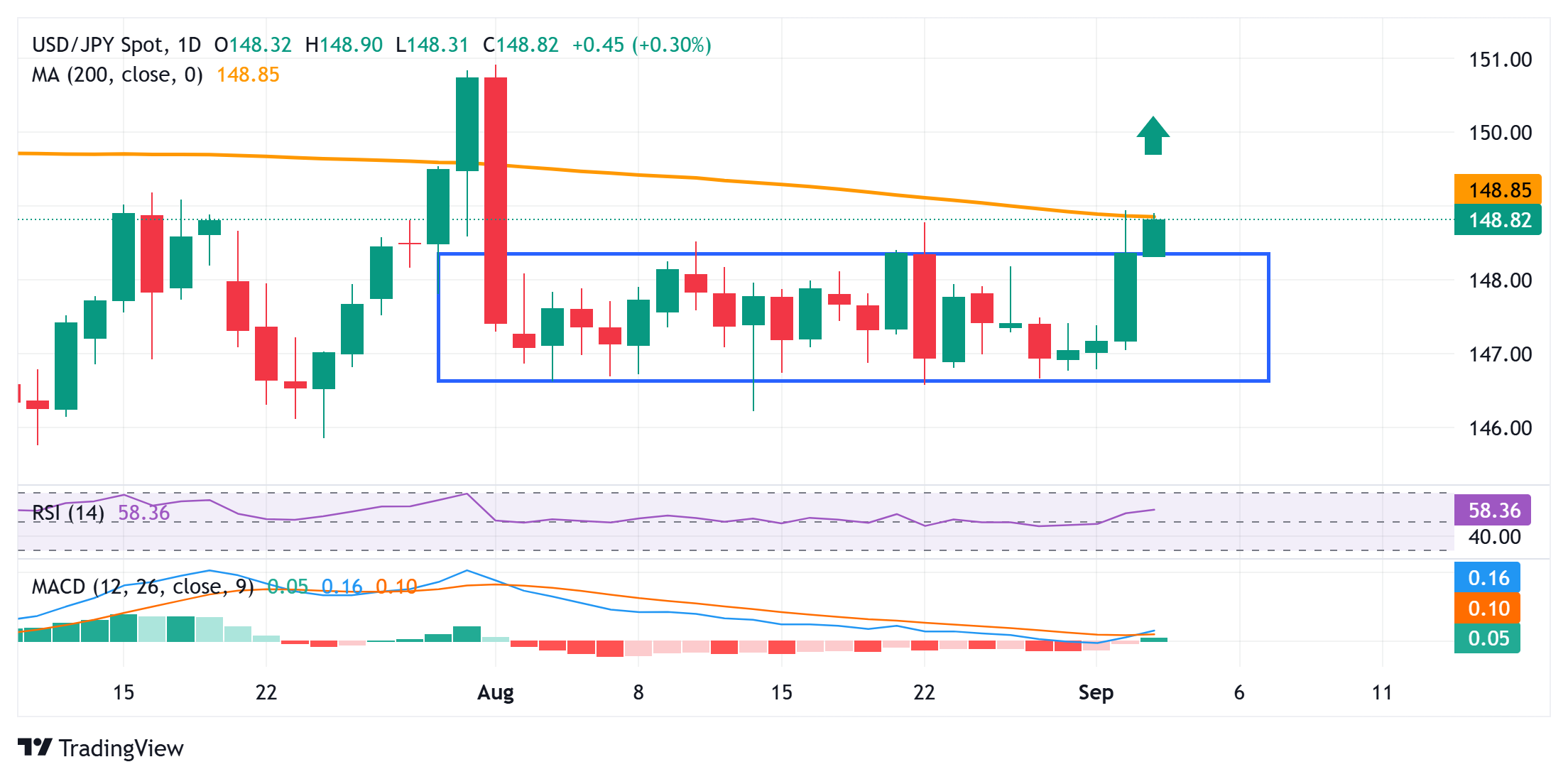Japanese Yen hangs near one-month low against USD; seems vulnerable ahead of US data
- The Japanese Yen retains its negative bias amid domestic political uncertainty and BoJ's rate hike plan.
- Some follow-through USD assists the USD/JPY pair to climb back closer to a one-month peak.
- The divergent BoJ-Fed expectations warrant some caution ahead of important US macro releases.
The Japanese Yen (JPY) maintains its offered tone through the Asian session on Wednesday amid heightened domestic political and trade-related uncertainties. Furthermore, the lack of hawkish signals from Bank of Japan (BoJ) Deputy Governor Ryozo Himino on Tuesday seems to encourage speculators to continue building short JPY positions. Apart from this, some follow-through US Dollar (USD) uptick lifts the USD/JPY pair back closer to a one-month top, around the 149.00 neighborhood touched the previous day.
Meanwhile, expectations that Japan's tight labor market could fuel further wage gains and boost inflation keep hopes alive for an imminent interest rate hike by the BoJ before the year-end. This marks a significant divergence in comparison to bets that the Federal Reserve (Fed) will lower borrowing costs later this month, which could act as a headwind for the USD and cap the upside for the USD/JPY pair. Traders might also refrain from placing aggressive directional bets ahead of the US Nonfarm Payrolls (NFP) report on Friday.
Japanese Yen is pressured by heightened political uncertainty and lack of hawkish BoJ signals
- The Japanese ruling party's secretary general, Hiroshi Moriyama, a close aide to Prime Minister Shigeru Ishiba, said on Tuesday he intends to resign from his post. Furthermore, Japanese media reported on Tuesday that former Prime Minister Aso Taro will publicly call for a new Liberal Democratic Party (LDP) presidential election on Wednesday.
- Bank of Japan Deputy Governor Ryozo Himino said on Tuesday the central bank should keep raising interest rates but warned that global economic uncertainty remains high. This, in turn, suggests that the BoJ is in no rush to push up still-low borrowing costs, which keeps the Japanese Yen depressed during the Asian session on Wednesday.
- Investors, however, seem convinced that the BoJ will stick to its policy normalization path as strong wage growth is expected to fuel demand-driven inflation. In contrast, traders are now pricing in around a 90% chance that the Federal Reserve will cut interest rates by 25 basis points at the end of a two-day policy meeting on September 17.
- The US Dollar trades with a positive bias for the second straight day and looks to build on the previous day's solid recovery move from the vicinity of the August monthly swing low amid the global flight to safety. This further assists the USD/JPY pair to retain its bullish bias and aim for a breakout through the 200-day Simple Moving Average.
- Traders now look forward to the release of the US JOLTS Job Openings data for some impetus later during the North American session. This week's US economic docket also features the ADP report on private-sector employment and ISM Services PMI on Thursday. The focus, however, will remain glued to the US Nonfarm Payrolls report on Friday.
USD/JPY could accelerate the positive move once the 200-day SMA barrier is cleared decisively

Some follow-through buying beyond the 200-day SMA and acceptance above the 149.00 mark will confirm a bullish breakout through a one-month-old trading range. Given that oscillators on the daily chart have just started gaining positive traction, the USD/JPY pair might then accelerate the positive move towards the next relevant hurdle near the 149.55-149.60 region. The momentum could extend further towards reclaiming the 150.00 psychological mark before spot prices eventually aim to challenge the August monthly swing high, around the 151.00 neighborhood.
On the flip side, the Asian session low, around the 148.30-148.25 region, could offer immediate support ahead of the 148.00 round figure. A convincing break below the latter could drag the USD/JPY pair to the 147.40 intermediate support en route to the 147.00 mark and the 146.70 horizontal zone. Failure to defend the said support levels might shift the bias back in favor of bearish traders and expose the August swing low, around the 146.20 region, before spot prices slide to the 146.00 mark.
Japanese Yen FAQs
The Japanese Yen (JPY) is one of the world’s most traded currencies. Its value is broadly determined by the performance of the Japanese economy, but more specifically by the Bank of Japan’s policy, the differential between Japanese and US bond yields, or risk sentiment among traders, among other factors.
One of the Bank of Japan’s mandates is currency control, so its moves are key for the Yen. The BoJ has directly intervened in currency markets sometimes, generally to lower the value of the Yen, although it refrains from doing it often due to political concerns of its main trading partners. The BoJ ultra-loose monetary policy between 2013 and 2024 caused the Yen to depreciate against its main currency peers due to an increasing policy divergence between the Bank of Japan and other main central banks. More recently, the gradually unwinding of this ultra-loose policy has given some support to the Yen.
Over the last decade, the BoJ’s stance of sticking to ultra-loose monetary policy has led to a widening policy divergence with other central banks, particularly with the US Federal Reserve. This supported a widening of the differential between the 10-year US and Japanese bonds, which favored the US Dollar against the Japanese Yen. The BoJ decision in 2024 to gradually abandon the ultra-loose policy, coupled with interest-rate cuts in other major central banks, is narrowing this differential.
The Japanese Yen is often seen as a safe-haven investment. This means that in times of market stress, investors are more likely to put their money in the Japanese currency due to its supposed reliability and stability. Turbulent times are likely to strengthen the Yen’s value against other currencies seen as more risky to invest in.

